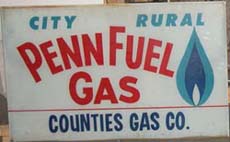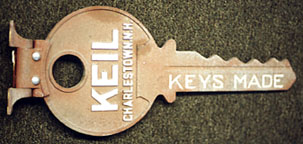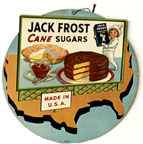|

Miscellaneous Signs & Displays
|

|
One of the more unusual signs in the
Museum's collection is this natural gas-powered illuminated
sign for Penn Fuel. The 6-ft. wide sign is fabricated
from copper and sheet metal and has a row of gas jets inside
the can, which illuminate the two glass sign faces. Lamps on
either end add to the illumination.
|
It is not known what era the sign represents, but it
is our opinion that the sign is not from turn-of-the-century, but is
a promotional effort on the part of the identified business to who
the power of natural gas. The sign was donated by Felix and Chris
Bartush, Bartush Signs, Orwigsburg, PA.
 |
No sign museum would
be complete without a Big Boy fiberglass sculpture, so
the local Cincinnati franchise-Frisch's Restaurants, Inc.-donated
a 1960s version of this famous American icon. Vice president
of marketing, Karen F. Maier, who coordinated the donation,
was very enthusiastic about the request, and sent various documentation
about the history of Big Boy restaurant signage. The donated
sculpture was lovingly restored by Eric Kilb, Steve McGowan
and the crew at Glass Hand, Cleves, OH (who incidentally were
also responsible for fabricating the pigs that recently populated
Cincinnati). |
| The significance of
the Elgin Watch Self-Winding Watch point-of-purchase display
is that it incorporates a painted bulletin to display the units
promotional text. The three-dimensional p-o-p unit incorporates
a plastic vintage car and a driver who appears to turn the auto's
crank, which is actually motorized and operates on its own.
The display incorporates two racks for displaying watches. |
|
  |
The Holiday Inn
sign is actually a scale model of the original "Great
Sign," donated to the Museum by the original manufacturer,
Cummings, Inc., Nashville, TN. The approximately 4 x 8-ft. sign
is a one-of-a-kind display built by Cummings for use by Holiday
Inn at tradeshows, grand openings and other public relation
events. The sign was featured at the Museum's "Signs
on Main Street" prototype unveiled at the International
Sign Associaiton's March 2001 Sign Expo in Las Vegas, NV. |
| The 30-in. tall cast aluminum key is
typical of a 1950s semi-production sign for a local locksmith. |
 |
 |
The 10-in. diameter, double-faced
cardboard sign dates from the 1930s and features an outdoor
painted bulletin as a backdrop for the ad copy. |
| The 30 x 80-in. outdoor board for Roberts
Dairy once sat in the lobby of this now defunct southern
Indiana business. The scale model is fabricated from a thin
composite board material, stretched and wrapped around a plywood
frame. The main copy is handcarved and gilded wood letters;
the balance of the text is handlettered in gold and outlined
in black. The oval pictorial is also handpainted. |
 |
|
|
Signtags, such as the sampling
shown here, are a part of sign history even when detached from
the sign they once identified. The examples here date from the
1920s ("R & H Strachan" . . . "We
made signs before we could talk") to the 1970s ("Heath"). |
| Whitbread & Company,
a British pub sign, is the first international object to be
acquired by the Museum and is courtesy of Terry Colley, Bull
and Brush, Stockport, England. The cast metal plaque is approximately
10 x 13 in. and was probably manufactured in the 1950s. |

|
|